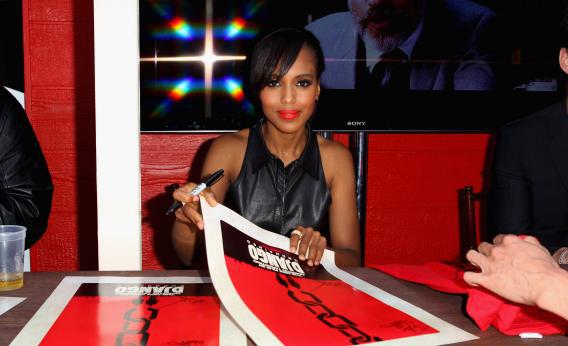The release of Quentin Tarantino’s spaghetti Western slavery revenge drama Django Unchained on the heels of Steven Spielberg’s rather more sober biopic Lincoln has given moviegoers a holiday season full of questions about one of the darkest periods in American history. Are we capable of reckoning with the racism of one of our most beloved presidents? Was vengefulness or reconciliation the more useful emotion in governing the reintegration of the seceded states—and individual slaveholders—into the Union? Did slaveholders really pit slaves against each other in fights to the death?
But one question raised unintentionally by both movies is why they ignore so much of the work that black women did to fight for their own freedom. In Lincoln, which portrays the machinations of an all-male legislature and Cabinet, with interjections by the president’s wife, Mary Todd Lincoln, that makes at least some historical sense. But both Broomhilda (Kerry Washington), the enslaved wife of Django (Jamie Foxx) in Tarantino’s movie, and Elizabeth Keckley (Gloria Reuben), the free black woman who is presented in Lincoln as Mary Todd Lincoln’s maid, are curiously blank, important only in how they motivate the black and white men around them.
In real life, Keckley bought her freedom and that of her son, and after petitioning for a license to work in Washington, D.C., began a career as a dressmaker, one that took off when she got as a client Mary Anna Custis Lee, the wife of eventual Confederate General Robert E. Lee. Keckley made dresses for Mary Todd Lincoln and dressed her for events, but she was not a servant. And three years after the president’s assassination, Keckley published a memoir called Behind The Scenes that, in its descriptions of the Lincolns, as well as the publication of letters from Mary, broke with previous norms of privacy, not to mention race and class.
That’s a fascinating story, and none of it, except an acknowledgement that Keckley was once enslaved, makes it into Lincoln. Instead of being the agent of her own freedom and an independent businesswoman, Keckley is a companion to Mrs. Lincoln, and an opportunity for the movie to have some mild discussion of the president’s less-than-perfectly-liberal racial views. “I don’t know you, Mrs. Keckley. Any of you,” the president tells her, explaining his perspective on black Americans. “I expect I’ll get used to you.” Keckley wants to know why she has to be an even more perfect role model than any other mother with a son fighting on the Union side. Lincoln doesn’t have an answer for her, and Lincoln doesn’t have any praise or attention for the work Keckley did to liberate herself long before her president committed himself to the same project.
At least Keckley gets to talk to the president, and to be a witness to the vote in the House of Representatives that passes the 13th Amendment to the Constitution prohibiting slavery. In Django Unchained, Broomhilda barely gets to be a person at all. Much of the time we see her only as her husband Django imagines her, naked and radiant in a hot spring in winter, beguiling in a yellow silk dress. In more realistic scenes, she’s whipped, branded, and pulled out of a sweat box—looking gorgeous the entire time—providing a different kind of motivation for her rescue.
The movie lets us know that, even as Django’s been mounting an epic quest to save Broomhilda, she’s tried to run away again of her own accord. But Django Unchained is more interested in her as an object of other people’s desires than in the courage that leads her to keep reaching for own freedom. The movie ends with her fingers stuck pertly in her ears as her husband dynamites the plantation house where she was last owned.
It’s true, as A.O. Scott wrote in his review of the movie that “The idea that regenerative violence could be visited by black against white instead of the reverse—that a man like Django could fill out the contours of the hunter—has been almost literally unthinkable.” But what’s unthinkable in the movies can be less ambitious than what actually happened in real life. It’s not as if there aren’t true and more ambitious stories to tell about women and the fight against slavery. If your taste runs to action, the story of Harriet Tubman’s work on the Underground Railroad and then as a scout and tactical planner for the Union Army might be a good place to start.
